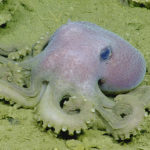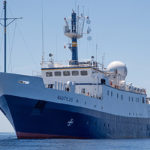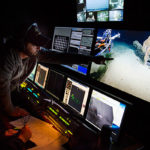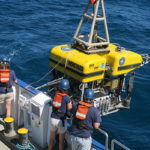This fall, NOAA’s Office of National Marine Sanctuaries is teaming up with Ocean Exploration Trust to explore the marine ecosystems of the West Coast and Hawaii. Working aboard the Exploration Vessel (E/V) Nautilus, scientists will map and explore targets from California to the Hawaiian Islands and Papahānaumokuākea Marine National Monument.
Researchers will conduct mapping operations and use remotely operated vehicles (ROVs) to investigate Monterey Bay and Channel Islands National Marine Sanctuaries as well as Papahānaumokuākea Marine National Monument in the Northwestern Hawaiian Islands. You can watch the livestream here.
The E/V Nautilus
The NOAA Office of Ocean Exploration and Research provides support for the complementary ocean exploration program of the E/V Nautilus, which operates under a similar paradigm as the NOAA Ship Okeanos Explorer.
The E/V Nautilus is equipped with telepresence, which will allow scientists from around the world to participate and contribute to the success of this mission. Telepresence will also bring the National Marine Sanctuary System and ocean science into the classroom, as students across the country will be able to directly engage with mission staff and operations.
For a full run-down of Nautilus‘ 2018 expedition plan and to watch live video, visit nautiluslive.org. Here’s a summary of the expedition’s upcoming voyages into your national marine sanctuaries:




Papahānaumokuākea Marine National Monument
Dates: September 14 – October 1, 2018
Lead scientists: Dr. Christopher Kelley, University of Hawaii; Dr. Thomas Hourigan, NOAA Deep-Sea Coral Research and Technology Program; Allison Fundis, Ocean Exploration Trust
Area of exploration: Papahānaumokuākea Marine National Monument, Hawaii
An unknown mechanism appears to have formed several seamounts in an unexplored part of Papahānaumokuākea Marine National Monument. This part of the expedition will map and conduct ROV dives on these seamounts to help determine how and when they formed, and to document the biological communities that presently live on them.
The seamounts are located between the Musicians Seamounts and the Hawaiian ridge and may be important to the connectivity between these two areas. The ROV dives will survey these seamounts for the presence of deep hig- density coral and sponge communities similar to those in the Musicians and on rift zone ridges on some of the Hawaiian banks.
Monterey Bay National Marine Sanctuary
Dates: October 21-31, 2018
Lead scientist: Chad King, Monterey Bay National Marine Sanctuary
Area of exploration: Monterey Bay National Marine Sanctuary, California
During this part of the expedition, scientists will visit an unexplored, deep-water (more than 10,000 feet) region within the borders of Monterey Bay National Marine Sanctuary. This area is a basaltic, rocky reef southeast of Davidson Seamount. Researchers seek to characterize the habitat, species, and communities that live there.
In 2009, Davidson Seamount Management Zone joined the area protected by Monterey Bay National Marine Sanctuary, expanding the sanctuary area by 775 square miles to a total of 6,094 square miles. Driving Davidson Seamount’s inclusion in the sanctuary was the discovery of communities of long-lived deep-sea corals and sponges during collaborative expeditions by NOAA, Monterey Bay National Marine Sanctuary, and the Monterey Bay Aquarium Research Institute in 2002, 2006, and 2007.
Although previous ROV dives have occurred on Davidson Seamount itself, unexplored deep, rocky habitat southeast of the seamount could harbor additional communities of corals and sponges. During this portion of the Nautilus expeditions, researchers intend to use the ROVs Hercules and Argus to document deep-water corals, sponges, and fishes, and collect biological samples. Researchers will also analyze water and sediment samples and collect environmental data that will help us understand the physical conditions of deep-water habitats.
Exploration of submerged shorelines on the California Borderland
Dates: November 2-14, 2018
Lead scientists: Dr. Robert Ballard, Ocean Exploration Trust; Dr. Larry Mayer, University of New Hampshire Center for Coastal Ocean Mapping
Area of exploration: Outer California Borderland, including parts of Channel Islands National Marine Sanctuary
In 2016, Nautilus partnered with Channel Islands National Marine Sanctuary and mapped areas within and around the sanctuary. During one of the ROV dives, researchers discovered evidence of the location of an ancient shoreline – an indication of past sea level.
During this part of the expedition, researchers will continue to identify and characterize the submerged shorelines associated with offshore banks in the Southern California region, including Channel Islands National Marine Sanctuary. This is a follow-up to the effort by Nautilus over the last four years to acquire high-resolution mapping data of submerged shorelines and characterize primarily with remotely operated vehicles.
The Channel Islands region has a complex geologic history that includes initial formation by submarine volcanism 19 to 15 million years ago, platform rotation, and extreme regional uplift. This study will aid in understanding the complex sea level change and tectonic history of the northern Channel Islands and Channel Islands National Marine Sanctuary.
By guest authors from NOAA
The post Live Underwater Exploration of America’ Marine Sanctuaries Coming this Fall appeared first on Scuba Diver Life.
from Scuba Diver Life https://ift.tt/2MUnjN3
No comments:
Post a Comment